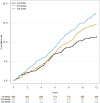The association between eicosanoids and incident atrial fibrillation in the Framingham Heart Study
- PMID: 36418854
- PMCID: PMC9684401
- DOI: 10.1038/s41598-022-21786-0
The association between eicosanoids and incident atrial fibrillation in the Framingham Heart Study
Abstract
Chronic inflammation is a continuous low-grade activation of the systemic immune response. Whereas downstream inflammatory markers are associated with atrial fibrillation (AF), upstream inflammatory effectors including eicosanoids are less studied. To examine the association between eicosanoids and incident AF. We used a liquid chromatography-mass spectrometry for the non-targeted measurement of 161 eicosanoids and eicosanoid-related metabolites in the Framingham Heart Study. The association of each eicosanoid and incident AF was assessed using Cox proportional hazards models and adjusted for AF risk factors, including age, sex, height, weight, systolic/diastolic blood pressure, current smoking, antihypertensive medication, diabetes, history of myocardial infarction and heart failure. False discovery rate (FDR) was used to adjust for multiple testing. Eicosanoids with FDR < 0.05 were considered significant. In total, 2676 AF-free individuals (mean age 66 ± 9 years, 56% females) were followed for mean 10.8 ± 3.4 years; 351 participants developed incident AF. Six eicosanoids were associated with incident AF after adjusting for multiple testing (FDR < 0.05). A joint score was built from the top eicosanoids weighted by their effect sizes, which was associated with incident AF (HR = 2.72, CI = 1.71-4.31, P = 2.1 × 10-5). In conclusion, six eicosanoids were associated with incident AF after adjusting for clinical risk factors for AF.
© 2022. The Author(s).
Conflict of interest statement
The authors declare no competing interests.
Figures

References
-
- Braunwald E. Shattuck lecture–cardiovascular medicine at the turn of the millennium: Triumphs, concerns, and opportunities. N. Engl. J. Med. 1997;337:1360–1369. - PubMed
-
- Franceschi C, Campisi J. Chronic inflammation (inflammaging) and its potential contribution to age-associated diseases. J. Gerontol. A Biol. Sci. Med. Sci. 2014;69(Suppl 1):S4–9. - PubMed
Publication types
MeSH terms
Substances
Grants and funding
- 5K01DK116917/GF/NIH HHS/United States
- U01 AG068221/AG/NIA NIH HHS/United States
- R01 HL092577/HL/NHLBI NIH HHS/United States
- R01 AG066010/AG/NIA NIH HHS/United States
- AHA_18SFRN34110082/AHA/American Heart Association-American Stroke Association/United States
- U54 AG065141/AG/NIA NIH HHS/United States
- R01 HL151828/HL/NHLBI NIH HHS/United States
- 5R01HL128914-04/GF/NIH HHS/United States
- R01 HL143227/HL/NHLBI NIH HHS/United States
- 5R01ES027595/GF/NIH HHS/United States
- R01 AG028321/AG/NIA NIH HHS/United States
- R01 HL131532/HL/NHLBI NIH HHS/United States
- R01 HL111314/GF/NIH HHS/United States
LinkOut - more resources
Full Text Sources
Medical

